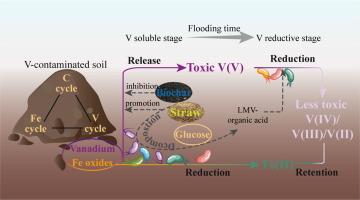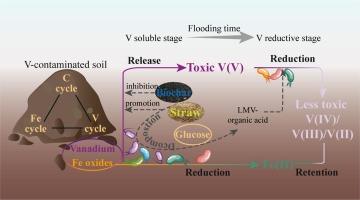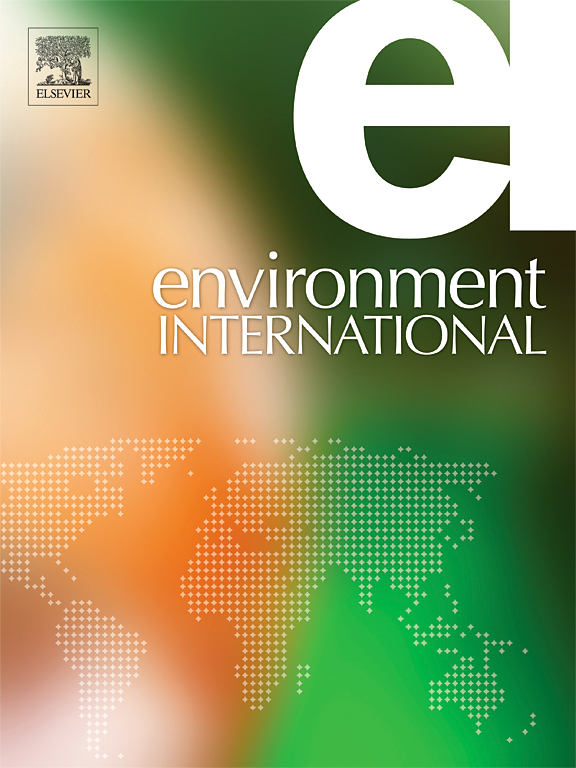在不同有机添加剂条件下,铁(III)还原介导了钒污染稻田土壤中钒的释放和还原
IF 10.3
1区 环境科学与生态学
Q1 ENVIRONMENTAL SCIENCES
引用次数: 0
摘要
受钒(V)污染的土壤中含有丰富的铁(Fe)氧化物,这是由于含钒和铁的矿物同时存在。然而,对土壤中氧化还原活性钒和铁的生物地球化学转化以及相关细菌的研究仍然较少。本研究探讨了在不同的有机添加剂条件下,微生物介导的有机物分解和铁(III)还原在多大程度上促进了受钒污染的稻田土壤中钒的释放/还原。土壤淹水减少了有毒的可还原钒,同时增加了毒性较低的可氧化钒。与对照处理相比,葡萄糖和秸秆促进了 V(V)的释放,使 V(V)浓度暂时增加了 73.59-106.34 毫克/千克,随后又促进了 V(V)的还原,使 V(V)浓度最终降至与对照处理相似的水平。在葡萄糖和秸秆添加剂中加入生物炭适度缓解了 V(V) 的释放。在 V 溶解过程中,Fe(II) 和 V(V) 浓度之间存在明显的正相关关系,这表明 Fe(III) 的还原与 V(V) 的释放存在时间上的耦合。梭状芽孢杆菌(Clostridium)和马西利亚菌(Massilia)介导了铁(III)的还原溶解和V(V)的释放,而嗜酸杆菌(Anaeromyxobacter)、鞘氨单胞菌(Sphingomonas)、布氏杆菌(Bryobacter)、酸性杆菌科(Acidobacteriaceae)和嗜酸杆菌科(Anaerolineaceae)则促进了V(V)的还原。这项研究加深了人们对与铁和碳循环相关的钒的生物转化的理解,并提出了通过调节铁(III)还原作用来减弱钒的释放或促进钒还原作用的钒污染土壤修复策略。本文章由计算机程序翻译,如有差异,请以英文原文为准。


Fe(III) reduction mediates vanadium release and reduction in vanadium contaminated paddy soil under different organic amendments
Vanadium(V) contaminated soil is abundant in iron(Fe) oxides due to co-occurrence of V and Fe bearing minerals. However, biogeochemical transformation of redox-active V and Fe in soil, and the bacteria involved, has remained less investigated. This study explored the extent to which microbial mediated organic decomposition coupled to Fe(III) reduction contributed to V(V) release/reduction in V-contaminated paddy soil under different organic amendments. Soil flooding decreased toxic reducible V while increased less toxic oxidizable V. Glucose and straw promoted V(V) release with temporarily increasing V(V) concentration by 73.59–106.34 mg/kg compared to the control treatment and subsequently promoted V(V) reduction with decreasing V(V) to concentrations eventually similar to the control treatment. Biochar incorporation under glucose and straw amendments moderately alleviated V(V) release. The significantly positive correlation between Fe(II) and V(V) concentrations during the V solubilization process indicated a temporal coupling of Fe(III) reduction and V(V) release. Clostridium and Massilia mediated Fe(III) reductive dissolution and V(V) release, while Anaeromyxobacter, Sphingomonas, Bryobacter, Acidobacteriaceae and Anaerolineaceae contributed to V(V) reduction. This study provides a deeper understanding of V biotransformation coupled to Fe and C cycling and suggests a remediation strategy for V-contaminated soils via regulating Fe(III) reduction to weaken V(V) release or to promote V(V) reduction.
求助全文
通过发布文献求助,成功后即可免费获取论文全文。
去求助
来源期刊

Environment International
环境科学-环境科学
CiteScore
21.90
自引率
3.40%
发文量
734
审稿时长
2.8 months
期刊介绍:
Environmental Health publishes manuscripts focusing on critical aspects of environmental and occupational medicine, including studies in toxicology and epidemiology, to illuminate the human health implications of exposure to environmental hazards. The journal adopts an open-access model and practices open peer review.
It caters to scientists and practitioners across all environmental science domains, directly or indirectly impacting human health and well-being. With a commitment to enhancing the prevention of environmentally-related health risks, Environmental Health serves as a public health journal for the community and scientists engaged in matters of public health significance concerning the environment.
 求助内容:
求助内容: 应助结果提醒方式:
应助结果提醒方式:


